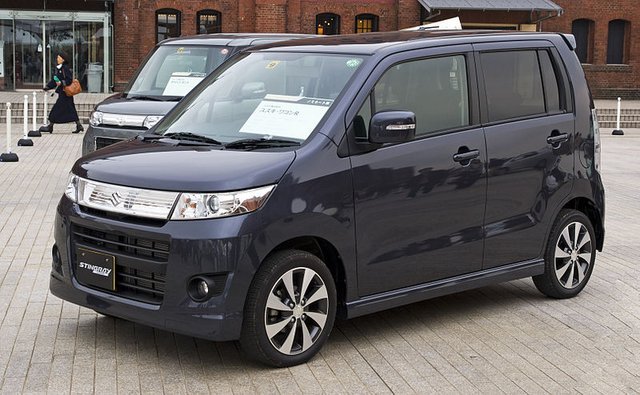Tiny ‘Kei Cars’ Are Big Sellers In Japan

More than a third of the vehicles sold in Japan are tiny, with engine sizes of 660 cubic centimeters or less.
The problem for Japan’s auto makers is that such cars’ profit margins are as small as the cars themselves and the vehicles are too Japan-focused to export to major markets in significant numbers, industry executives say.
What’s worse, the customer base here for the vehicles—known as kei, or light cars—is aging rapidly, along with Japan’s population.
The average kei-car buyer is close to 50 years old, up from just over 42 at the start of the last decade, according to trade groups. Of the 1.4 million minis expected to be sold this year, more than one in four will be bought by a driver 60 or over. Only 13% of buyers were 29 or under, the latest industry data show, a worrisome trend for car companies as Japan’s population begins to fall.
Yet the minis market got even more crowded last year, when Toyota Motor Co., Japan’s biggest auto maker, jumped in to compete with Nissan Motor Co. and Honda Motor Co.
“It sounds like a contradiction, working on minicars in Japan,” says Sho Minekawa, chief operating officer for Honda’s regional sales operations. “But the technologies to make small cars cheaper will be crucial, and a thorough study of it through minicars in Japan will help enter other countries.”
Satoshi Nagashima, a consultant with Roland Berger Strategy Consultants, says, “It’s not impossible to sell minicars overseas.” The kei car, however, “is a bit too small” to sell abroad.
Nevertheless, the minis market remains highly competitive here, in part because it is a rare growth segment for Japan’s auto sales. It also is a way of maintaining brand loyalty. Until last year, for example, an aging Toyota Prius owner wishing to trade down to a less expensive vehicle would have had no option but to switch to another brand. Selling a low-margin Toyota is better than sending customers straight to competitors’ showrooms.
The minis market—rooted in Japan’s need for inexpensive, personal vehicles as it reindustrialized after World War II—long has been dominated by small-car specialists Suzuki Motor Co. and Daihatsu Motor Co., 51% of which is owned by Toyota. The vehicles have lower tax rates than bigger cars, provided they meet the latest specifications, which were set more than a dozen years ago: an engine of no more than 660 cubic centimeters, up to 1.48 meters wide, up to 3.4 meters long and no higher than two meters. That makes a kei car narrower than German auto maker Daimler AG’s smart fortwo city car, which has grown in popularity in Europe in recent years.
While Japan’s domestic auto sales shrank to just 4.2 million vehicles in 2011, following last year’s March earthquake, from 7.8 million vehicles in 1990 the share of minivehicles rose to 36% from 23%.
Improvements to safety, fuel economy and, in some years, government incentives for buying more environmentally friendly cars have played a part in that growth. So, too, has the swelling ranks of Japan’s older consumers watching their budgets by trading down from bigger, more-expensive vehicles.
Fumitaka Takiura, a 43-year-old office worker who lives in a Tokyo suburb with his wife and two children, said he is thinking about getting rid of his Nissan Elgrand minivan and buying a minivehicle. “There are fewer chances to go out with my kids as they have grown up,” he says. “We don’t need a big minivan any more. Also gasoline prices are high.”
Daihatsu and Suzuki have moved to tap into the shift in demographics toward older and female drivers. Daihatsu hired 57-year-old Hollywood actor Bruce Willis for commercials in which he learns to pronounce the name of its Mira e:S vehicle in Japanese, then jauntily takes credit for its success. Suzuki hired actress Karina, a regular in feel-good television dramas and movies, to hawk its Alto ECO minicar.
Both the Mira e:S, with a basic starting price of ¥795,000, or about $10,000, and the Alto ECO, which starts at ¥860,000, cost less than half Toyota’s popular Prius hybrid. Daihatsu says the Mira e:S is profitable. Suzuki declines to comment on the profitability of the Alto ECO.
Among the three biggest Japanese auto makers, Honda is the only one to make kei cars itself. It added to its repertoire last year by introducing the NBox, a more spacious mini for families, with a slogan in English, “Hello, Small World.”A new model based on the NBox platform is expected to be released soon. Toyota sells rebadged minicars made by Daihatsu. Nissan sells minivehicles made by Suzuki and Mitsubishi Motors Co.
Nissan Chief Operating Officer Toshiyuki Shiga questions whether developing minicars makes sense. “Is it really a good thing for Japanese car makers that cars sold in Japan are sold only here?” he asked at a recent news conference. “I think it’s time to think about it.”
In the near term, though, minicar sales prospects are bright here, industry insiders say.
“Minis will continue to grow” as the overall industry rebounds, says Honda’s Mr. Minekawa. “Once the total market returns to five million vehicles, [minicars] will hit two million over the next five years.”
Nouvelles connexes


